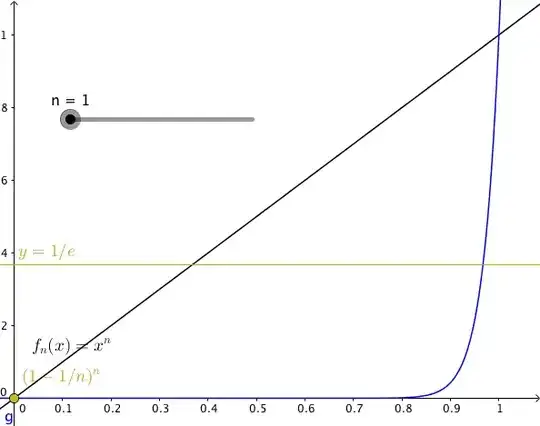Here's a useful generalization of the limit definition of $e$ from the OP:
Given
$$e = \lim_{n\to\infty}\left(1+\frac{1}{n}\right)^n$$
Raise both sides to the power of $x$:
$$e^x = \lim_{n\to\infty}\left(1+\frac{1}{n}\right)^{nx}$$
This is trivially true when $x = 0$, as both sides evaluate to 1
Assume $x \ne 0$ and let $m = nx$, i.e., $n = \frac{m}{x}$
As $n\to\infty, \, m\to\infty$
$$e^x = \lim_{m\to\infty}\left(1+\frac{x}{m}\right)^{m}$$
[Note the similarity between this and the first limit in Marc van Leeuwen's answer].
In particular, for $x = -1$
$$e^{-1} = \lim_{m\to\infty}\left(1+\frac{-1}{m}\right)^{m}$$
or
$$e^{-1} = \lim_{m\to\infty}\left(1-\frac{1}{m}\right)^{m}$$
As mathmandan notes in the comments, my derivation is flawed when $x < 0$, since then $n\to\infty \implies m\to -\infty$ :oops:
I'll try to justify my result for negative $x$ without relying on the fact that $e^x$ is an entire function and that there is only a single infinity in the (extended) complex plane.
For any finite $u, v \ge 0$, we have
$$e^u = \lim_{n\to\infty}\left(1+\frac{u}{n}\right)^{n}$$
and
$$e^v = \lim_{n\to\infty}\left(1+\frac{v}{n}\right)^{n}$$
Therefore,
$$e^{u-v} = \lim_{n\to\infty}\left(\frac{1+\frac{u}{n}}{1+\frac{v}{n}}\right)^{n}$$
Let $m = n + v$. For any (finite) $v$ as $n\to\infty, \, m\to\infty$.
$$\begin{align}\\
\frac{1+\frac{u}{n}}{1+\frac{v}{n}}
& = \frac{n + u}{n + v}\\
& = \frac{m + u - v}{m}\\
& = 1 + \frac{u - v}{m}\\
\end{align}$$
Thus
$$\begin{align}\\
e^{u-v} & = \lim_{n\to\infty}\left(1+\frac{u - v}{m}\right)^{n}\\
& = \lim_{m\to\infty}\left(1+\frac{u - v}{m}\right)^{m-v}\\
& = \lim_{m\to\infty}\left(1+\frac{u - v}{m}\right)^m \lim_{m\to\infty}\left(1+\frac{u - v}{m}\right)^{-v}\\
& = \lim_{m\to\infty}\left(1+\frac{u - v}{m}\right)^m\\
\end{align}$$
since
$$\lim_{m\to\infty}\left(1+\frac{u - v}{m}\right)^{-v} = 1$$
In other words,
$$e^{u-v} = \lim_{m\to\infty}\left(1+\frac{u - v}{m}\right)^m$$
is valid for any finite $u, v \ge 0$. And since we can write any finite $x$ as $u-v$ with $u, v \ge 0$, we have shown that
$$e^x = \lim_{n\to\infty}\left(1+\frac{x}{n}\right)^{n}$$
is valid for any finite $x$, so
$$e^{-x} = \lim_{n\to\infty}\left(1+\frac{-x}{n}\right)^{n}$$
And hence
$$e^{-x} = \lim_{n\to\infty}\left(1-\frac{x}{n}\right)^{n}$$
